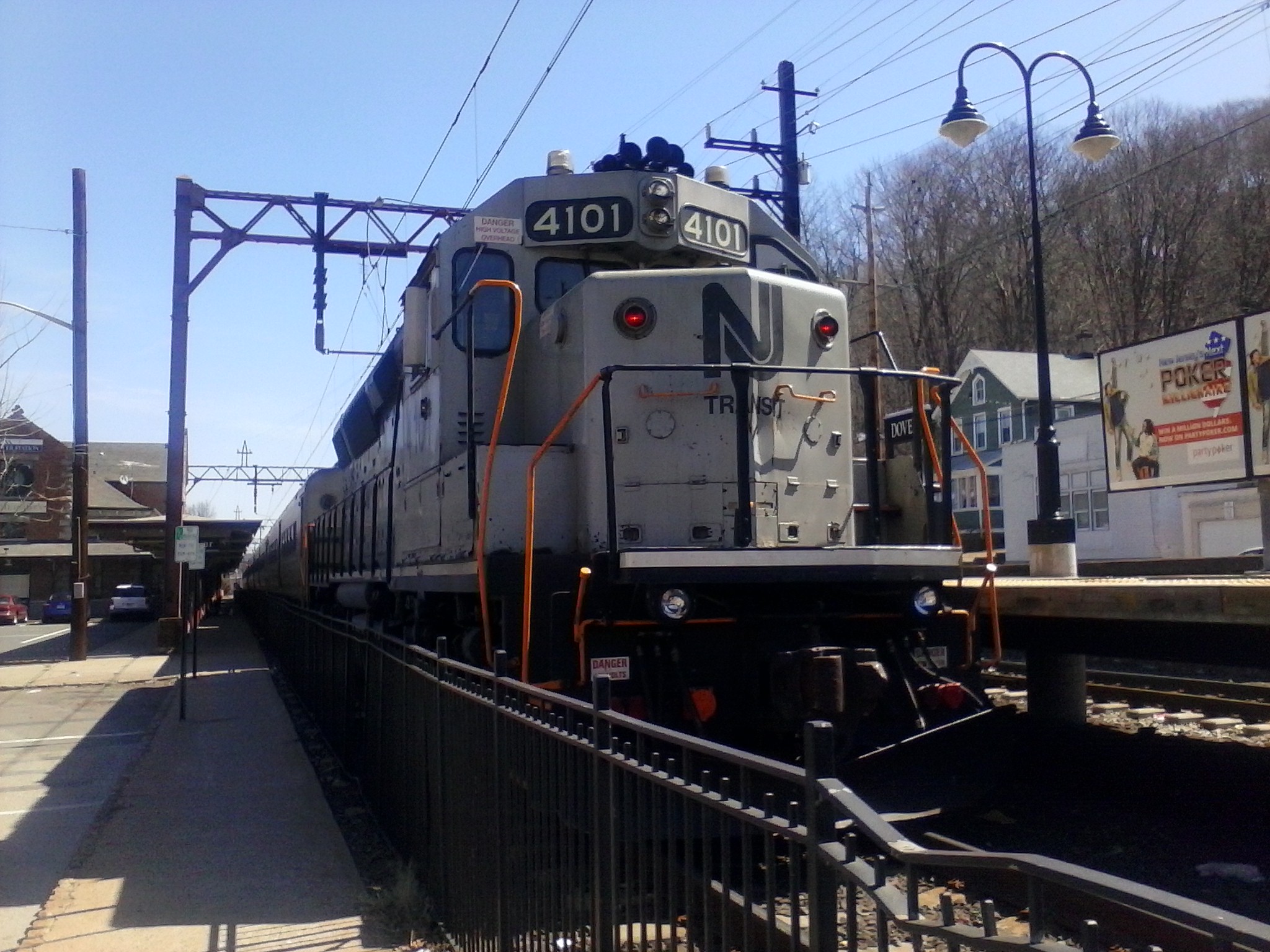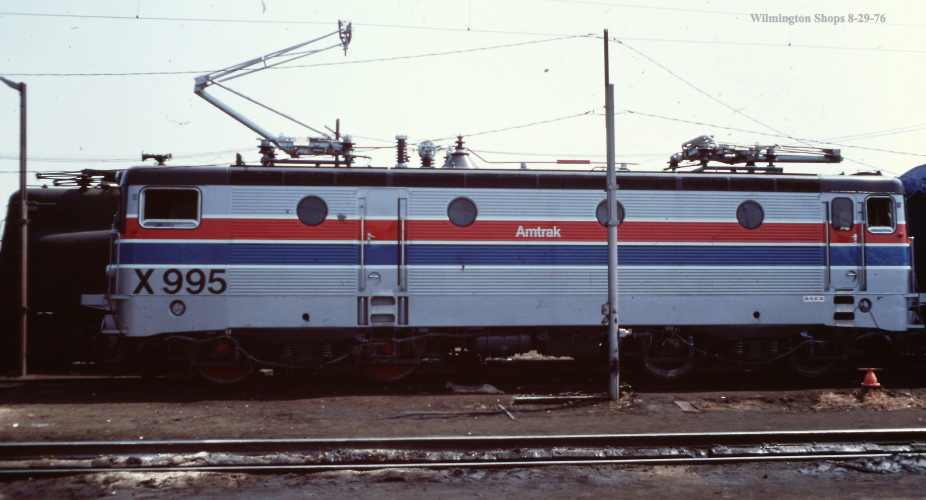|
ALP-44
The ABB ALP-44 was an electric locomotive which was built by Asea Brown Boveri of Sweden between 1989 and 1997 for the New Jersey Transit and SEPTA railway lines. Service New Jersey Transit New Jersey Transit acquired 32 ALP-44s for use on its electric railway lines. The first fifteen, numbered 4400–4414 and designated ALP-44O (Original), were delivered in 1990 (prototypes 4400 and 4401 in late 1989). Five additional units, numbered 4415–4419 and designated ALP-44E (Extended), were delivered in 1995. The final 12 locomotives, numbered 4420–4431 and designated ALP-44M (Microprocessor), were delivered in 1996 for the new Midtown Direct service. NJT's ALP-44s were to be overhauled for a cost of $2 million during a two-year period by Philadelphia-based Interfleet Technology. A car builder had not yet been selected to carry out the overhaul. However, by June 2009, NJT decided that it would be more efficient (economically and physically) to replace the ALP-44s rather than over ... [...More Info...] [...Related Items...] OR: [Wikipedia] [Google] [Baidu] |
NJ Transit Rail Operations
NJ Transit Rail Operations is the rail division of NJ Transit. It operates commuter rail service in New Jersey, with most service centered on transportation to and from New York City, Hoboken, and Newark. NJ Transit also operates rail service in Orange and Rockland counties in New York under contract to Metro-North Railroad. The commuter rail lines saw riders in , making it the second-busiest commuter railroad in North America as well as the longest by route length. This does not include NJ Transit's light rail operations. Network and infrastructure The lines operated by NJ Transit were formerly operated by the Pennsylvania Railroad, Central Railroad of New Jersey, New York and Long Branch Railroad and Erie Lackawanna Railroad, most of which date from the mid-19th century. From the 1960s onward, the New Jersey Department of Transportation began subsidizing the commuter lines. By 1976, the lines were all operated by Conrail under contract to NJDOT. The system took its ... [...More Info...] [...Related Items...] OR: [Wikipedia] [Google] [Baidu] |
SEPTA Regional Rail
The SEPTA Regional Rail system is a commuter rail network owned by the Southeastern Pennsylvania Transportation Authority and serving the Philadelphia Metropolitan area. The system has 13 branches and more than 150 active stations in Philadelphia, Pennsylvania, its suburbs and satellite towns and cities. It is the fifth-busiest commuter railroad in the United States, and the busiest outside of the New York and Chicago metropolitan areas. In 2016, the Regional Rail system had an average of 132,000 daily riders and 118,800 daily riders (As of 2019). The core of the Regional Rail system is the Center City Commuter Connection, a tunnel linking three Center City stations: the above-ground upper level of 30th Street Station, the underground Suburban Station, and Jefferson Station (formerly Market East Station). All trains stop at these Center City stations; most also stop at Temple University station on the campus of Temple University in North Philadelphia. Operations are ... [...More Info...] [...Related Items...] OR: [Wikipedia] [Google] [Baidu] |
Atlantic City Express Service
The Atlantic City Express Service (ACES) was an inter-city train service offered by the Borgata, Caesars Atlantic City, and Harrah's Atlantic City, operating from February 2009 until September 2011. It was operated by New Jersey Transit under contract, and funded by the Casino Reinvestment Development Authority. The train provided summer seasonal service between New York City and Atlantic City three days a week, operating along the Northeast Corridor and Atlantic City Line. The train was formally discontinued on March 9, 2012. Background With the success of NJT's commuter service to Atlantic City, talks about direct service to New York were discussed. In June 2006, the board of New Jersey Transit accepted a plan for an express service between Atlantic City, New Jersey and Pennsylvania Station in Midtown Manhattan, for a three-year trial initially slated to begin in 2007 ( Newark Penn was not initially intended as a stop, but it would be added during the planning stages). Because ... [...More Info...] [...Related Items...] OR: [Wikipedia] [Google] [Baidu] |
EMD AEM-7
The EMD AEM-7 is a twin-cab four-axle B-B electric locomotive built by Electro-Motive Division (EMD) and ASEA between 1978 and 1988. The locomotive is a derivative of the Swedish SJ Rc4 designed for passenger service in the United States. The primary customer was Amtrak, which bought 54 for use on the Northeast Corridor and Keystone Corridor. Two commuter operators, MARC and SEPTA, also purchased locomotives, for a total of 65. Amtrak ordered the AEM-7 after the failure of the GE E60 locomotive. The first locomotives entered service in 1980 and were an immediate success, ending a decade of uncertainty on the Northeast Corridor. In the late 1990s, Amtrak rebuilt 29 of its locomotives from DC to AC traction. The locomotives continued operating through the arrival of the final Siemens ACS-64 in June 2016. MARC retired its fleet in April 2017 in favor of Siemens Chargers, and SEPTA retired all seven of its AEM-7s in November 2018 in favor of ACS-64s. Background Amtrak assume ... [...More Info...] [...Related Items...] OR: [Wikipedia] [Google] [Baidu] |
Siemens ACS-64
The Siemens ACS-64, or Amtrak Cities Sprinter, is an electric locomotive designed by Siemens Mobility for use on the Northeast Corridor (NEC) and the Keystone Corridor in the northeastern United States. The design was based on locomotives Siemens created for use in Europe and Asia, but with changes to comply with American standards. The ACS-64 is built at the Siemens factory in Florin, California, located outside of Sacramento. The first 70 locomotives were built for Amtrak to replace the railroad's fleet of aging AEM-7 and unreliable HHP-8 locomotives. The first ACS-64 entered service in February 2014 and deliveries continued until August 2016. SEPTA Regional Rail in Southeastern Pennsylvania operates a fleet of 15 ACS-64s since August 2018, on the agency's commuter rail routes. Design The design is based on the EuroSprinter and the Vectron platforms, which Siemens sells in Europe and Asia. Significant structural changes to the design were made to comply with Ameri ... [...More Info...] [...Related Items...] OR: [Wikipedia] [Google] [Baidu] |
ALP-46
The Bombardier ALP-46 is an electric locomotive built in Germany by Bombardier between 2001 and 2002 for use in the United States. It is derived from the German Class 101. New Jersey Transit (NJT) is the only railroad to operate this locomotive model, which is used across the electrified NJT system, specifically on the Northeast Corridor, North Jersey Coast, Morris & Essex, and Montclair-Boonton lines. These locomotives replaced the ALP-44 locomotives, which were all retired by 2012. Orders and delivery NJT ordered 29 locomotives: the first 24 ALP-46 locomotives in December 1999 and an additional five locomotives in September 2001. They were built by Bombardier (formerly ADtranz) at their Kassel, Germany plant. The first two locomotives were built as preseries locomotives for testing—4600 was tested on the TTCI test plant in Pueblo, Colorado, 4601 was sent to Kearny for testing on the NJT network. All locomotives were transported via road to the port of Bremen and shippe ... [...More Info...] [...Related Items...] OR: [Wikipedia] [Google] [Baidu] |
SJ Rc
The Rc class is the most used electric locomotive in Sweden. Rc is a universal locomotive used both in freight and passenger trains. The largest operator is Green Cargo, although SJ, Tågab, Hector Rail and the Swedish Transport Administration operate it as well. Previous operators include Veolia Transport. History The Rc-locomotive first appeared in 1967 to replace the older D-locomotives. The locomotives are notable for using thyristors instead of the older relay based system. Usage As of 2020, Rc-locomotives are still used all over Sweden in both passenger and freight lines, although on passenger trains they are slowly being replaced by new EMU, such as ER1. Versions Altogether, there have been eight versions of the Rc-locomotive in Sweden, including the freight locomotive Rm designed to pull iron ore trains. Rc1, Rc2, Rc4, and Rc5 have a maximum allowed speed of 135 km/h. Rc3 and Rc6 have a maximum allowed speed of 160 km/h. Rc7 was a rebuild of Rc6 meant t ... [...More Info...] [...Related Items...] OR: [Wikipedia] [Google] [Baidu] |
Stanhope, New Jersey
Stanhope is a borough in Sussex County, New Jersey, United States. As of the 2010 United States Census, the borough's population was 3,610,DP-1 - Profile of General Population and Housing Characteristics: 2010 for Stanhope borough, Sussex County, New Jersey , . Accessed September 16, 2012. [...More Info...] [...Related Items...] OR: [Wikipedia] [Google] [Baidu] |
Amtrak
The National Railroad Passenger Corporation, doing business as Amtrak () , is the national passenger railroad company of the United States. It operates inter-city rail service in 46 of the 48 contiguous U.S. States and nine cities in Canada. ''Amtrak'' is a portmanteau of the words ''America'' and ''trak'', the latter itself a sensational spelling of ''track''. Founded in 1971 as a quasi-public corporation to operate many U.S. passenger rail routes, Amtrak receives a combination of state and federal subsidies but is managed as a for-profit organization. The United States federal government, through the Secretary of Transportation, owns all the company's issued and outstanding preferred stock. Amtrak's headquarters is located one block west of Union Station in Washington, D.C. Amtrak serves more than 500 destinations in 46 states and three Canadian provinces, operating more than 300 trains daily over of track. Amtrak owns approximately of this track and operates an ... [...More Info...] [...Related Items...] OR: [Wikipedia] [Google] [Baidu] |
AAR Wheel Arrangement
The AAR wheel arrangement system is a method of classifying locomotive (or unit) wheel arrangements that was developed by the Association of American Railroads. Essentially a simplification of the European UIC classification, it is widely used in North America to describe diesel and electric locomotives (including third-rail electric locomotives). It is not used for steam locomotives, which use the Whyte notation instead. The AAR system counts axles instead of wheels. Letters refer to powered axles, and numbers to unpowered (or idler) axles. "A" refers to one powered axle, "B" to two powered axles in a row, "C" to three powered axles in a row, and "D" to four powered axles in a row. "1" refers to one idler axle, and "2" to two idler axles in a row. A dash ("–") separates trucks or wheel assemblies. A plus sign ("+") refers to articulation, either by connecting bogies with span bolsters or by connecting individual locomotives via solid drawbars instead of couplers. 1A-A1 ... [...More Info...] [...Related Items...] OR: [Wikipedia] [Google] [Baidu] |



.png)